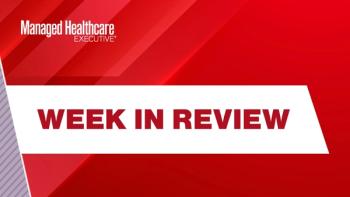
- MHE November 2020
- Volume 30
- Issue 11
No Pushing, no Shoving. Instead, Nudges in the Right Direction
Applying lessons from behavioral economics, health systems are using “nudges” to influence the choices clinicians make.
A physical nudge is not a push or shove, but a gentle prod (often with the well-placed elbow) to pay attention, to wake up, to look over there.
But today we are enveloped in a swarm of behavioral nudges, partly because we are riveted to our electronic devices. Amazon’s Alexa and Apple’s Siri ping us appointment reminders, tell us when to take the meal out of the oven, and prepare us to take that upcoming left turn at the light.
Nudges—and the technologies to deliver them—are becoming an increasingly important part of American healthcare. They are being used to keep patients safe, steer doctors and consumers to make more cost-effective decisions, and improve the quality of care. The trick to nudges, say experts, is for them to be not too controlling while putting people on a path to the “best” choice. Behavioral nudges, which can include setting defaults and digital reminders to offer chances at small financial rewards, need to anticipate innate flaws in human thinking that tend to overvalue immediate rewards and misjudge probabilistic scenarios.
EHRs are an opportunity
The behavioral nudge is a concept from the field of behavioral economics. In 2017, Richard Thaler won the Nobel Memorial Prize in Economics for his work on behavioral economics, a field that combines economics with the psychology of making decisions. Nudges don’t restrict or force a choice or involve strong monetary incentives but instead help guide a stakeholder to a preferred option, says Mitesh Patel, M.D., MBA, director of the Penn Medicine Nudge Unit, which claims to be the first behavioral “design team” embedded in health system.
In healthcare, nudges originated out of a desire to improve patient safety; among the first nudges were notifications about allergies and adverse reactions to medications. “If a provider tried to order a medication and a patient had a documented allergy or adverse reaction to it, a pop-up would stop the physician and require them to either change the order or give a valid reason why they still wanted to order it,” says Joyce Brown, B.S.N., RN, the clinical informatics coordinator at Deborah Heart and Lung Center, a hospital specializing in cardiovascular and lung disease in southern New Jersey.
Nudging has branched out from there partly because the electronic health record (EHR) makes it relatively easy to use defaults and reminders to guide healthcare decisions. Patient portals and conversations between patients and clinicians also present chances for nudges to take place.
“There are opportunities to work through all of these mediums to align nudges with improved medical decision-making,” Patel says.
Patel and his colleagues at the Penn Medicine Nudge Unit have worked with clinicians from more than a dozen specialties to implement nudges in healthcare. The unit’s success stories include changing default settings in the EHR to increase generic prescribing from 75% to 98%, increasing referrals to cardiac rehabilitation for heart attack patients from 15% to 85%, and decreasing unnecessary imaging among patients with cancer at the end of their life from 68% to 32%. They have also used active choice prompts to remind clinicians to address gaps in care which have increased influenza vaccination, cancer screening and statin prescribing.
Physicians at Deborah Heart and Lung use nudges as reminders of best practices. “They are a way to provide guidance, but ultimately physicians make the decision for the type of care delivered,” Brown says.
Nudges can be used to help providers follow guidelines set by CMS, other government entities, and other organizations. Brown says that if certain protocols are required or recommended, nudges can increase the number of clinicians who follow them. If certain protocols are required that involve a number of tests, medications, or treatments, physicians can order all of them at the same time, Brown says.
Getting the alignment right
Because nudges can be very powerful, they need to be implemented carefully. “We focus on driving outcomes using national guidelines and evidence-based criteria,” Patel says. “They are most useful when a specific decision point can be targeted to significantly shift decision-making behavior.”
Poorly designed nudges that seem coercive or counterproductive can backfire. Nudges should be designed to create a path of least resistance around a choice so that whoever is being nudged will be receptive to it, experts say. “Nudges can be made difficult to opt out of to increase the likelihood of behavior change, but it is important that a nudge actually aligns with what the people being nudged would see as either in their or society’s best interests,” says Kevin Volpp, M.D., Ph.D., director of the Penn Center for Health Incentives and Behavioral Economics and one of the world’s foremost experts on nudges and behavioral economics in healthcare.
“Well-designed nudges based on clinical evidence make it easier for clinicians to effectively treat patients based on the latest evidence,” Volpp says. “This can save time while also increasing the effectiveness and value of their care.”
But as with any other strategy or tactic designed to influence behavior, nudges can be overdone. In the realm of patient safety, “alarm fatigue” can set in so that safety alerts end up having the opposite of their intended effect because clinicians tune them out. “If a physician receives too many alerts, they may lose their importance,” Brown says.
Money is an obstacle
At the University of Pennsylvania, raising generic prescribing rates by using nudges is considered one of the big behavioral economics success stories because it saved the health system about $32 million in the two and a half years after it was implemented.
“Before the prescribing default was changed to generic medications, clinicians weren’t opposed to prescribing generics, but they were unlikely to take the time to sift through a long list of alternatives to find one,” Volpp says. “Making it easy for clinicians to prescribe generics created a pathway whereby nearly 100% of clinicians now prescribe them.” Volpp says setting generics as a default is a good example of how making the optimum choice easier can guide people to a choice they might have made by themselves had they had more time to consider the decision.
Brown cites Deborah Heart and Lung Center’s sepsis program as one of its greatest successes with nudges. The hospital created a sepsis surveillance board that identified patients with early signs of sepsis. “If they truly show signs of sepsis, we have protocols that include CMS guidelines for sepsis care including timing of labs, fluids, and medications, and electronic documents to prompt the physician with what needs to be charted in order to meet regulations,” Brown said. She believes the program has been successful because physicians have everything they need at their fingertips.
Nudges have their limitations. Volpp says behavior change is unlikely to happen if there are strong financial incentives to stick with the status quo or to make a different change. “Nudges can have a significant influence on what patients and physicians do, but it’s difficult for nudges to overcome strong monetary incentives that induce behaviors,” Volpp says.
If, for example, a clinician is compensated primarily for doing procedures, nudges to do fewer procedures are unlikely to have sufficient power to offset the compensation. In contrast, nudges can be highly effective for, say, decreasing antibiotic prescribing rates if there isn’t any countervailing incentive driving that behavior.
Karen Appold is a medical writer in the Lehigh Valley region of Pennsylvania.
Articles in this issue
almost 5 years ago
Positive results for Darzalex, Jakavi to be reported at ASHalmost 5 years ago
Headed in the Right Direction: Cancer Mortality is Going Downalmost 5 years ago
5 More Takeaways About the Telehealth Boomalmost 5 years ago
5 Takeaways About the Telehealth Boomalmost 5 years ago
SDOH Is a Hot Ticket. But Are the Programs Mainly for Show?almost 5 years ago
Lung Cancer Treatment: Bespoke and Guided by Biomarkersalmost 5 years ago
Bringing CAR-T Cell Therapy to the Communityalmost 5 years ago
Insurers Take up Mantle to Ensure Immunizationsalmost 5 years ago
Five Important Advances in Breast Cancer TreatmentNewsletter
Get the latest industry news, event updates, and more from Managed healthcare Executive.

















































